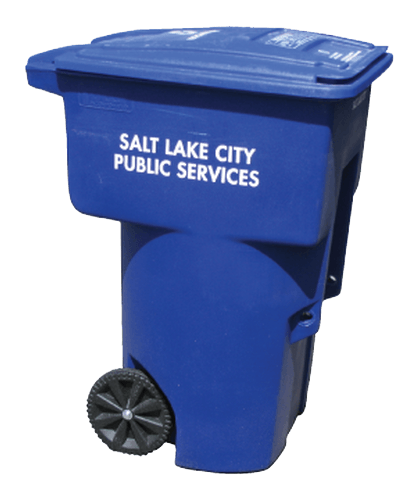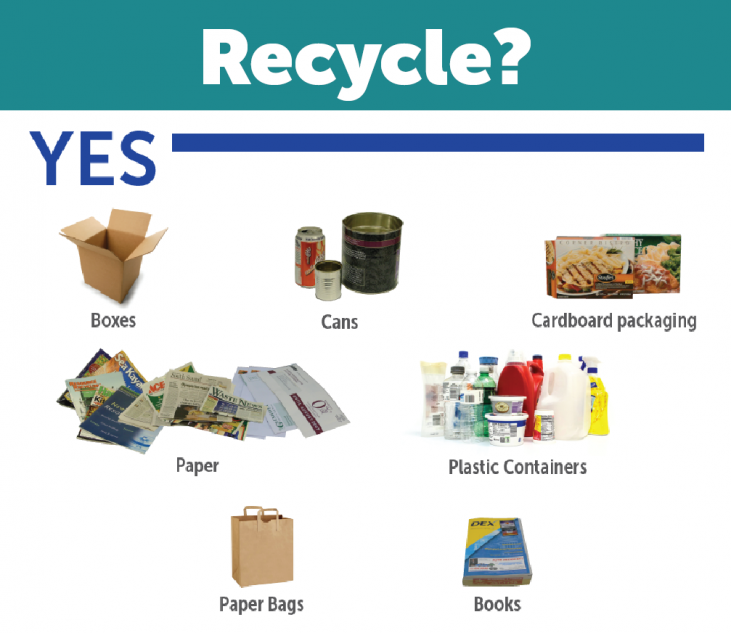What Can I Put in My Curbside Recycling Container?



Download the full Salt Lake City curbside services brochure.
Haga clic aquí para descargar el folleto completo de servicios en la acera de Salt Lake City en español.
Curbside Recycling
Maintaining a robust recycling program is a core function of Salt Lake City’s Sustainability Department. However, in 2018, the recycling world was shaken up by changes announced by China, which has affected recycling facilities worldwide. This includes local Utah processors used by Salt Lake City (read more on the SLCgreen blog).
The principles of 1) Reduce 2) Reuse and then 3) Recycle are more important than ever.
What materials can be recycled in your curbside recycling?
Please help us by only putting the correct items in your blue container. The following restrictions are now in effect for Salt Lake City curbside bins:
- Please do not put plastic bags, films, or wraps of any kind in the blue container. (Learn more)
- Do not enclose recyclables in plastic bags or kitchen bin liners (i.e. do not “bag your recyclables.”) This will prevent your items from being recycled.
- No expanded polystyrene (“Styrofoam“)
- No shredded paper.
Yes!
- Newspaper and newspaper inserts
- Cardboard boxes, shoe boxes, cereal boxes, paper tubes
- Magazines and phone books
- Aluminum cans
- Steel (tin) food cans
- Plastic containers (like milk jugs, plastic bottles, plastic cups, yogurt containers, etc)
- Junk mail, office paper, envelopes
- Aerosol cans – please make sure they are drained by turning them upside down and releasing the pressure.
No!
- Glass (Sign up for curbside glass recycling or take yours to a community drop-off location.)
- Food, food residue, or food wrappings – empty all food and food residue from containers
- Napkins, paper towels, toilet paper, paper plates
- Aseptic cartons (these are shelf-stable cartons. Some are known as “TetraPaks”)
- Clothing
- Electronics, computers, small appliances
- Yard waste
- Toys, garden hoses, plastic swimming pools
- Home improvement/construction materials
- Plastic bags (learn why here)
- Styrofoam – including take-out containers and block foam.
- Shredded paper
Recycling FAQ
Click the accordion menus for answers to your recycling questions.
Do our recyclable materials actually get recycled?
YES!
- Aluminum cans are recycled within the U.S. and get turned back into new aluminum products such as new cans, bicycle parts, airplane parts, and more.
- Steel cans are recycled in Utah at Nucor and get turned into industrial steel products.
- Plastic containers numbered 1, 2, 4, and 5 are recycled within the U.S. and get turned back into new plastic products.
- Cardboard and paper are recycled within the U.S and internationally and get turned back into a variety of new paper products.
What about plastic containers numbered 3, 6, and 7?
We are currently not able to divert #3, #6, and #7 plastics. However, at this time, we are continuing to accept containers numbered #3, #6 (such as Solo cups), and #7 as we look for viable opportunities to divert this relatively small volume of material (1.4 – 1.5% of our stream). Recycling markets shift regularly. Please note that this does not include Styrofoam, which is not accepted in Salt Lake City’s recycling program.
Why can't recyclables be bagged in my recycling bin?
Most recycling sorting facilities do not have the ability to rip open bags in order to process the materials inside. Additionally, the bags themselves can clog the sorting equipment. Keep all items loose and separate within your recycling bin.
Why can't I put Styrofoam in my recycling bin?
Expanded Polystyrene (aka Plastic #6, aka “Styrofoam”) is made of 98% air and is therefore difficult to process. Block Styrofoam may be recycled at drop-off locations listed on our Additional Recycling Resources page.
Other Styrofoam products like to-go containers and meat trays are not currently recyclable at all in Utah.
Why do you only accept plastic containers?
Recycling sorting facilities are not designed or equipped to process anything other than plastic containers so other plastics simply cannot be accepted.
Plastic bags, plastic sheeting, plastic wraps, and plastic films pose several problems for sorting facilities. Soft plastics clog sorting equipment. They are also made of all types of different plastic which is difficult to identify and impossible to sort; they are lightweight; and they end up as litter around sorting facilities.
You can recycle many plastic bags, wraps, and films at retail stores such as Smiths, WinCo, Target, Walmart, and many more. These stores have collection barrels up front where plastic film and bags are collected and processed separately. This avoids the problems soft plastics cause at mixed sorting facilities.
Is shredded paper recyclable?
Not in your curbside recycling bin.
By itself, shredded paper is too small to be captured at the sorting facility where SLC’s recyclables are separated to be recycled. Additionally, anything that is bagged up will not get recycled, so shredded paper cannot go in bags in your recycling bin.
You can drop off shredded paper to International Paper Recycling at 2590 W. 1500 S. in SLC or find the closest Green Fiber paper recycling dumpster (located at most Salt Lake City School District schools) and put your shredded paper in boxes or paper bags to be recycled through their paper-only recycling program.
Shredded paper is inherently less recyclable than sheets of paper because shredding shortens the paper fibers. We encourage you to rip off and shred only the information that is confidential on a document. You can recycle the remainder of the non-shredded paper in your blue bin.
Why can't I put scrap metal in my recycling bin?
Scrap metal can damage both the trucks that pick up your recycling and the sorting facility that processes the materials. Additionally, sorting facilities are only designed to capture metal in the form of cans. Searching on the web will turn up many robust scrap metal recycling facilities that take all types of metal that can be recycled locally.
Is it still worth it to recycle?
YES!
Recycling conserves resources and reduces pollution. For example, aluminum is a limited resource. Recycling uses 95% less water and 95% less energy to make the new product than it does to make it out of raw aluminum ore. Recycling other materials also results in energy and water savings, while also conserving raw materials like trees (for paper products) and natural gas or oil (for plastic products).
So keep on recycling and know that your efforts make a difference!
This statistic is unfortunately accurate. However, that is a very broad statistic that takes into account production of all plastics, including durables. Thankfully we have a much more positive story to tell here at least with the single stream recycling we collect from Salt Lake City residents and a few small businesses. By the numbers, we collect an average of just over 700 tons (1.4 million lb) per month of single stream recycling. About 11%, or 77 tons/154,000 lb, of that is plastic. Only about 1%, or approximately 1,500 lb, of all our plastic is 3/6/7/”other” that is either burned for fuel in a local cement kiln or sent to landfill.Is it true that under 10% of plastics are actually being recycled nationally? How much collected plastic is Salt Lake City recycling?
All plastics we collect in the City are delivered to the Waste Management Material Recovery Facility (“MRF”) here in Salt Lake City. They sort PET #1, natural and colored HDPE #2 (separately), and a mix of LDPE #4 and Polypropylene #5 (together) into their respective streams and bale to densify for transportation to end use facilities located primarily in the US, but there are a few in Canada and Mexico as well. Materials are not converted at the MRF located here. What little remaining plastic (3, 6, 7, “other”) remains in stream is either landfilled or being burned for fuel locally in cement production.Where does plastic waste collected by the City go?
PET is remade into fiber that goes into a variety of uses in textiles and flooring. Currently it is mainly being used in carpet manufacturing. HDPE is primarily going into irrigation pipe and other HDPE packaging. LDPE & PP are further sorted/separated and typically become packaging made from those materials (ie paint buckets).What is City collected plastic waste converted into?
Recycling by the Numbers
Salt Lake City collects recyclables from an estimated 45,000 residential homes, and 650 small businesses and multi-family complexes every day, five days per week. An average of 750 tons of material are recycled each month.
Recycling this amount of material each month saves the equivalent of:
- 7,379 mature trees (91,427,200 sheets of copy paper)
- 3,030 cubic yards of landfill space (the annual space needed for 3,891 people)
- 2,353,583 kWh of electricity (enough to power the needs of 225 homes)
- 2,604 metric tons of greenhouse gas emissions
- 4,011,430 gallons of water (enough to meet the daily needs of over 50,000 people).
In June 2019, Salt Lake City recycled 585 tons of cans, bottles, paper, and cardboard, saving the following resources:

Source: Waste Management, June 2019 stats.
Help us achieve our Zero Waste Goals
The City currently recycles or composts 42% of the waste collected from residents. Our goal is to reach 50% in the next several years.
See the Joint Resolution passed in 2011 to set Salt Lake City on the path toward Zero Waste.
Thank you for Reducing, Reusing, and Recycling!
.